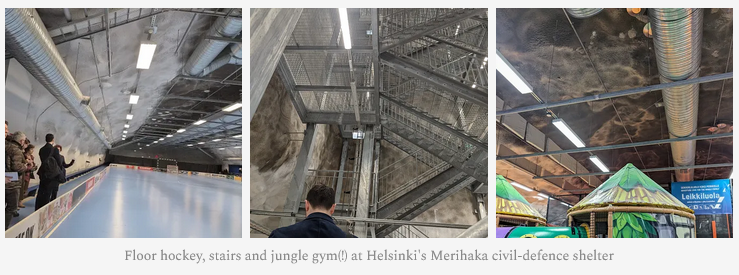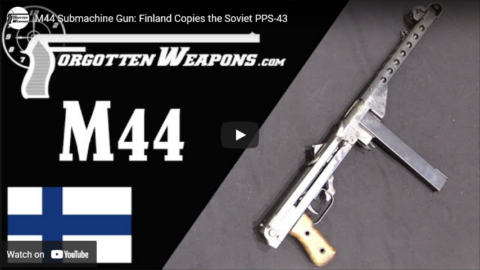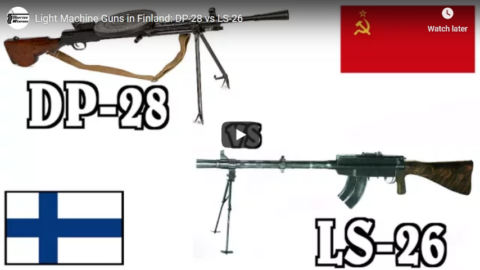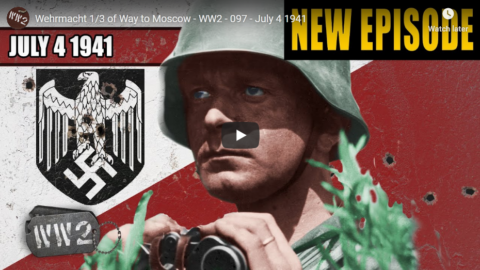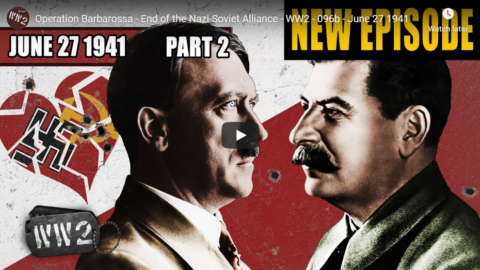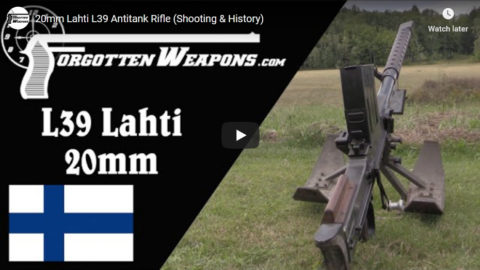Forgotten Weapons
Published May 13, 2024During the 1930s, there was interest in Finland in replacing the Maxim heavy machine gun with something handier and more mobile. There were experiments with large drum magazines for the LS-26 light machine gun, but these were not satisfactory. Aimo Lahti began to work on a gas-operated GPMG, but lack of funding and competing priorities led to it having slow progress until the eve of the Winter War. By the time the gun was completed and the first preproduction batch ready for troop trials, the Continuation War was underway.
Twenty eight of the L41 Sampo machine guns were sent out to a variety of units for field testing in the fall of 1942, and the guns were generally well liked, although not perfect. Before improvements and full-scale production could begin, though, the Finnish military was basically distracted by an alternative possibility of procuring MG42 receivers from Germany and building them into complete guns in 7.62x54R. At least one such prototype was completed, and that project caused the L41 program to stall. By the time it might have progressed, the war was going rather badly for Germany and the possibility of getting receivers was basically gone. The L41 never did see further refinement or production, although the trials guns remained in service with their units, in a few cases right until the end of the war.
Mechanically, the L41 is a fascinating hybrid of Bren/ZB and Maxim elements, and incredibly sturdily built. Only seven are know to survive today, six in Finland and this one in the UK. Thanks to the British Royal Armouries for giving me access to it to film for you!
(more…)
August 27, 2024
Finland’s Prototype Belt-Fed GPMG: L41 Sampo
July 10, 2024
Two World Wars: Finnish C96 “Ukko-Mauser”
Forgotten Weapons
Published Mar 27, 2024A decent number of C96 Mauser pistols were present in Finland’s civil war, many of them coming into the country with the Finnish Jaegers, and others from a variety of sources, commercial and Russian. They were used by both the Reds and the Whites, and in both 9x19mm and 7.63x25mm. After the end of the civil war, when the military was standardizing, the C96s were handed over to the Civil Guard, where they generally remained until recalled to army inventories in 1939. They once again saw service in the Winter War and Continuation War, and went into military stores afterwards until eventually being surplussed as obsolete.
One of the interesting aspects of Finnish C96s is that many of them come from the so-called “Scandinavian Contract” batch (for which no contract has actually turned up). These appear to be guns made in 7.63mm that were numbered as part of the early production in the Prussian “Red 9” series, probably for delivery to specific German units or partner forces during World War One.
(more…)
March 27, 2024
Civil Defence is a real thing in Finland
Paul Wells reports back on his recent trip to Finland, where he got to tour one of the big civil-defence shelters in Helsinki:
One of the best playgrounds for children in Helsinki is the size of three NFL football fields, dug into bedrock 25 metres below a street-level car park, and built to survive a nuclear bomb.
The air down here is surprisingly fresh. The floor-hockey rinks — there are two, laid end to end — are well maintained. The refreshment stands are stocked with snacks. The steel blast doors are so massive it takes two people to slam one shut.
Finland has been building civil-defence shelters, methodically and without fuss, since the late 1950s. This one under the Merihaka residential district has room for 6,000 people. It’s so impressive that it’s the Finnish capital’s unofficial media shelter, the one visiting reporters are likeliest to be shown. The snack bar and the jungle gym are not for show, however: as a matter of government policy, every shelter must have a second, ordinary-world vocation, to ensure it gets used and, therefore, maintained between crises.
The Merihaka shelter was one of the stops on my visit to Helsinki last week. The first anniversary of Finland’s membership in NATO, the transatlantic defence alliance, is next week, on April 4. Finland’s foreign office invited journalists from several NATO countries to visit Helsinki to update us on Finland’s defence situation. I covered my air travel and hotel. Or rather, paid subscribers to this newsletter did. Your support makes this sort of work possible. I’m always grateful.
The Finnish government used to build most of the shelters. But since 2011, the law has required that new shelters be built at the owners’ expense, by owners of buildings larger than 1,200 square metres and industrial buildings larger than 1,500 square metres.
The city of Helsinki has more shelter space than it has people, including visitors from out of town. Across the country the supply is a little tighter. Altogether today Finland has a total of 50,500 shelters with room for 4.8 million people.
That’s not enough for the 5.5 million people in Finland. But then, if war ever comes, much of the population won’t need shelter, because they’ll be staying groundside to fight.
Conscription is universal for Finnish men between 18 and 60. (Women have been enlisting on a voluntary basis since the 1990s.) The standing armed forces, 24,000, aren’t all that big. But everyone who finishes their compulsory service is in the reserves for decades after, with frequent training to keep up their readiness. In a war the army can surge to 280,000. In a big war, bigger still.
The Soviet Union invaded Finland in 1939, during what was, in most other respects, the “phony war” phase of the Second World War. The Finnish army inflicted perhaps five times as many casualties on the Soviets as they suffered, but the country lost 9% of its territory and has no interest in losing more. Finland’s foreign policy since then has been based on the overriding importance of avoiding a Russian invasion.
June 11, 2023
The Invasion of Normandy begins! – WW2 – Week 250 – June 10, 1944
World War Two
Published 10 Jun 2023The Allies’ gigantic amphibious invasion of France begins and by the end of the week they’ve carved out a decent-sized beachhead. Meanwhile in Italy the Allied advance takes Rome. The Soviets are launching new attacks of their own — now against the Finns, and the Japanese at Kohima … have just plain had enough.
(more…)
May 3, 2023
Finland’s High Power Rig
Forgotten Weapons
Published 6 Jan 2023Finland used a variety of FN pistols prior to WW2, and had already evaluated the High Power when Russian invaded and the Winter War began. With an urgent need for more arms, Finland ordered a batch of High Power pistols, which FN was happy to include with the other arms orders already being delivered to Finland. In total, the Finns bought 2,400 of them, with 900 delivered in February 1940 and 1,500 in March 1940. All of them were bought as rigs with leather holsters riveted to flat board shoulder stocks (note that a Finnish pistol with a Finnish-contract original stock is exempted form the NFA in the US, and need not be registered as a short-barreled rifle).
This delivery schedule meant that only a few were available in time to be used in the Winter War, and they saw much greater use in the Continuation War. They were particularly appreciated by the Finnish Air Force as survival weapons. This is often misinterpreted to mean that they were exclusively used by the Air Force; in fact the quantity of Finnish aircraft was small enough that only a small fraction of the pistols were issued to pilots.
Finnish contract pistols have serial numbers falling between 11,000 and 15,000 (and not all guns in that range are Finnish). The stocks were marked in large numbers with the serial number of the gun, although matching rigs are quite scarce today. Some, but not all, were later marked “SA” by the Finnish Army. During the continuation War some of the holsters were separated from the stocks, and some of the pistols had new square front sights put on (a common Finnish preference, done to Lugers as well).
About 40% of the High Powers were lost or rendered unserviceable by the end of the Continuation War. The remainder were kept in service until the 1980s, when they were replaced by the Browning Double Action and slowly sold as surplus.
(more…)
March 29, 2023
Will Finland Leave the War? – WW2 Special
World War Two
Published 28 Mar 2023The Finns have been fighting the Soviet Union since the Winter War. But now, Marshal Mannerheim and Prime Minister Risto Ryti look like they might pull out of the Eastern Front commitments they agreed upon with their Axis allies. German-Finnish relations seem to be at breaking point, and Red Army troops are threatening the borders. How long will Finland stay in this war?
(more…)
September 15, 2022
Lahti L-35: Finland’s First Domestic Service Automatic Pistol
Forgotten Weapons
Published 23 Apr 2018When Finland decided to replace the Luger as its service handgun, they turned to Finland’s most famous arms designer, Aimo Lahti. After a few iterations, Lahti devised a short recoil semiautomatic pistol with a vertically traveling locking block, not too different from a Bergmann 1910 or Type 94 Nambu. It was adopted in 1935, but production did not really begin in earnest until 1939 at the VKT rifle factory. Several variations were made as elements of the gun were simplified to speed up production, and the design was also licensed to the Swedish Husqvarna company, which manufactured nearly 10 times as many of the pistols as VKT eventually did.
In today’s video we will look at each of the variations, including one with an original shoulder stock and the early and late military guns as well as the post-war commercial guns marked Valmet instead of VKT.
(more…)
July 18, 2022
Russian Invasion of Finland – The Winter War 1939-40
Mark Felton Productions
Published 24 Mar 2022Find out why Russia invaded neutral Finland in late 1939, and how the outnumbered and outgunned Finns managed to defend their country for 3 months until making peace with Stalin.
(more…)
March 21, 2022
M44 Submachine Gun: Finland Copies the Soviet PPS-43
Forgotten Weapons
Published 17 Nov 2021http://www.patreon.com/ForgottenWeapons
https://www.floatplane.com/channel/Fo…
Cool Forgotten Weapons merch! http://shop.forgottenweapons.com
The kp/31 Suomi submachine gun in Finnish service was an outstanding weapon, but it was slow and expensive to manufacture. When Finnish forces began capturing Soviet PPS-42 and PPS-43 submachine guns from the Soviets in the Continuation War, it was very quickly decided that Finland should copy the design. This was a far simpler, far cheaper stamped sheet-metal design that was not as refined as the Suomi, but much more efficient to make.
The Sudayev design was changed only minimally; primarily to fit the Finnish cartridge (9x19mm Parabellum) and magazines. The guns were originally designed to use the 50-round quad-stack boxes and 71/72 round drums of the Suomi, but also used the Swedish Carl Gustaf m/45 magazine that was adopted by Finland after WW2.
Two companies were approached to produce the M44; Tikkakoski and Ammus Oy. Ammus was unable to source raw materials for the project, and only Tikka put the guns into production. Marshal Mannerheim initially wanted 50,000, but the order was reduced to 20,000 — of which only 10,000 were actually made, due to limited material availability before the end of the war led to production ending. Another 400 were assembled from remaining parts after the war.
In the 1950s, a plan was begun to resume M44 production in order to completely replace the Suomi in Finnish inventory. However, this plan was interrupted when Sam Cummings of InterArms made a deal to trade Finland about 75,000 surplus Sten guns for Finland’s supply of 7.35mm Carcano rifle (received as aid from Italy during the war) along with a melange of old machine guns. This was a sufficient quantity of Stens to handle the duties of the Suomi, and so the Sten went into Finnish service and M44 production was never resumed.
Those Carcano rifles were in turn imported into the United States, and this is why the majority of 7.35mm Carcano here bear Finnish “SA” property stamps. The same is true for the significant number of Chauchat automatic rifles in the US with Finnish property marks, which were also part of the deal.
Contact:
Forgotten Weapons
6281 N. Oracle 36270
Tucson, AZ 85740
June 11, 2021
Is Finland an Ally of Nazi Germany? – Carl Gustaf Mannerheim – WW2 Biography Special
World War Two
Published 10 Jun 2021Carl Gustaf Mannerheim is a national hero after his service in everything from the Finnish Civil War to the Winter War. But did he plan a war of aggression with Nazi Germany against the Soviet Union? And if so, did Hitler and Stalin even give him any choice in the matter?
(more…)
January 10, 2021
Light Machine Guns in Finland: DP-28 vs LS-26
Forgotten Weapons
Published 20 Jul 2017http://www.patreon.com/ForgottenWeapons
Before the Winter War, the standard light machine gun adopted by the Finnish military was the Lahti-Saloranta LS-26. This was a complex and finely built weapon, using a short recoil action and tilting bolt, chambered for the same 7.62x54mm rimmed cartridge as used by Finland’s Mosin-Nagant infantry rifles. The LS-26 fed from 20-round box magazines which are a bit unusual in having a single-feed presentation (which made them difficult to load without a tool, but also prevented potential problems from rimlock).
In total, about 5,000 LS26 machine guns were made for Finland (and an additional 1,200 sold to China in 8mm Mauser). They were apparently quite accurate, but highly prone to malfunctioning in the cold and dirty field conditions of Finnish combat. When the Winter War broke out and Finns began capturing Russian equipment, the Russian DP-28 light machine gun became a very popular alternative to the LS-26.
The Degtyarev DP-28 may not have been as refined of a weapon, but it was much better suited to real combat. It was simple and reliable, and the 47-round magazine capacity was certainly appreciated as well. By the end of the Continuation War, Finland had some 15,000 Degtyarev light machine guns in its inventory, far outnumbering the LS-26s.
Today Karl and I had a chance to fire both weapons side by side (unfortunately, my trigger time on the LS-26 was quite limited, and I was not able to film a full disassembly of it). We both found the LS-26 to be quite a challenging weapon to use effectively, even without any malfunctions. The Degtyarev was a much more usable machine gun.
One other interesting takeaway for us was the remarkable effectiveness of the semiautomatics DP/DPM made by SMG Guns here in the US. It delivered probably 90% of the utility of the original fully automatic version, which is quite impressive. After this comparison, I would recommend it even more heartily than before.
Special thanks to Varusteleka for arranging this shoot!
All photos in this video are courtesy of the excellent Finnish Defense Forces’ Photo Archive:
http://sa-kuva.fiCool Forgotten Weapons merch! http://shop.bbtv.com/collections/forg…
If you enjoy Forgotten Weapons, check out its sister channel, InRangeTV! http://www.youtube.com/InRangeTVShow
July 5, 2020
June 28, 2020
June 25, 2020
20mm Lahti L39 Antitank Rifle (Shooting & History)
Forgotten Weapons
Published 12 Sep 2016Sold for $10,350.
The Lahti L39 was the Finnish answer to the need for an anti-tank rifle, developed just before the Winter War. The rifle was created by noted Finnish designed Aimo Lahti, who had pressed for it to use a 13.2mm cartridge. However, arguments for using a 20x138B cartridge won out, based on hopes to use that cartridge in both antitank and antiaircraft roles, as well as testing that showed the 20mm projectile to have greater terminal effect.
The L39 was not available for use in the Winter War (having been adopted barely 2 months before the Russian attack), but was used extensively in the Continuation War. While improved tank armor quickly became thick enough to protect against the round, it was used for a variety of anti material roles, attacking machine gun positions, bunkers, light vehicles, and more. In 1944, an anti-aircraft version was also produced, firing in full auto and using 15-round magazines.
Today, ammunition is available from a few companies, typically using lathe-turned new cases and surplus 20mm Vulcan projectiles.
May 19, 2020
The Battle of Tali-Ihantala 1944
TIK
Published 18 May 2020The Battle of Tali-Ihantala narrated with unit movements over a map, backed by sources (listed in the description).
In 1944 The Red Army of the Soviet Union attacked the Finnish Army on the VKT Line during the Continuation War, resulting in the Battle of Tali-Ihantala. Here are the major unit movements during the battle and a discussion regarding the statistics and the interpretation of the battle. #WW2 #ContinuationWar
Videos EVERY Monday at 5pm GMT (depending on season, check for British Summer Time).
Want to ask a question? Please consider supporting me on either Patreon or SubscribeStar and help make more videos like this possible. For $5 or more you can ask questions which I will answer in future Q&A videos. Thank you to my current Patrons! You’re AWESOME! https://www.patreon.com/TIKhistory or https://www.subscribestar.com/tikhistory
– – – – –
BIBLIOGRAPHY / SOURCES
The main sources used for this video –
Lunde, H. Finland’s War of Choice: The Troubled German-Finnish Coalition in World War II. Casemate Publishers, 2011.
Nenye, V. Finland at War: The Continuation and Lapland Wars 1941-45. Osprey Publishing, Kindle 2016.
And (unfortunately) also wikipedia – https://en.wikipedia.org/wiki/Battle_of_Tali-IhantalaFull list of all my sources https://docs.google.com/spreadsheets/…

